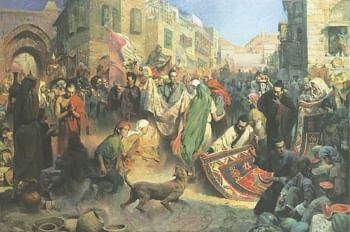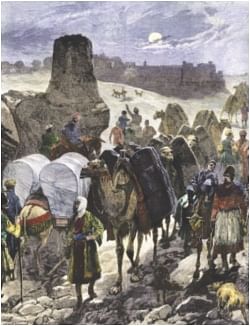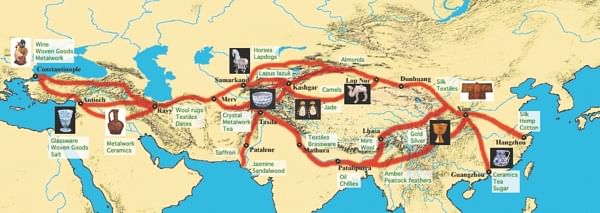| Home - Back Issues - The Team - Contact Us |
 |
| Volume 11 |Issue 39| October 05, 2012 | |
|
|
A Roman Column A CENTRAL ASIAN JOURNEY Neeman Sobhan
Even before I leave the Eternal city, I dream of another city, as ancient as Rome, and as legendary as Babylon, rising like a mirage from the sands, glowing like a camp fire in a desert, drawing caravans of camels loaded with resplendent silk fabrics and porcelain from China, spices and gems from India, Italian glass, Byzantine gold, Turkish rugs, cakes of soap, kegs of gunpowder, kilos of tea, bales of paper, tusks of ivory, ingots of silver, monkeys on chains and peacocks in cages; led by merchants and traders, adventurers and storytellers, monks and musicians; moving goods and ideas, science and art, Islam and Buddhism from east to west and west to east. A blue-tiled and domed city on the most famous trade route in history: the Silk Road. I imagine swaying on a camel's back through a dusty gold trail, approaching the walls, minarets and bazaars shimmering in the distance. I dream of Samarkand: “Sweet to ride forth at evening from the wells/When shadows pass gigantic on the sand, And softly through the silence beat the bells/Along the Golden Road to Samarkand.” Yes, the journey has not even started and already the famous poem of James Elroy Flecker, “The Golden Road to Samarkand,” rings in my memory like bells. In my fancy, I am the Venetian traveller Marco Polo, not of history but that of Italo Calvino's “Invisible Cities” who after describing one imaginary city after another to Kublai Khan, is told by the emperor: From now on I will describe the cities to you, and in your journeys you will see if they exist. My brief is not from Kublai Khan but culled from my own years of words and images from the pages of history books, guide brochures, poems, paintings, literature and Classics illustrated Comics, as I start off from the land of Marco Polo in quest of the city of my dreams along the Silk Road.
Actually, I set off not from Italy but from Tashkent. And first, we need to arrange our modern day travel, not by camel but a camel faced metallic beast with the speed of a bird. It's the new high speed train, bought by the Uzbeks from Spain, which at 250 mph takes us in only 2 hours to Samarkand. But while we are still whizzing through the dry steppes of Uzbekistan, let us imagine what this Silk Road was all about in the past. But for now, my train window faces flat grassy and scrub lands, mountain passes, then fertile river valleys. Uzbekistan is situated between two rivers: the Amu-darya and Syr-darya, and has the internal Aral sea to its west, but otherwise, it is a double landlocked country, surrounded by other landlocked countries like Kazakhstan, Kyrgyzstan, Tajikistan, Afghanistan, and Turkmenistan. Located thus in the unavoidable middle of Central Asia, Uzbekistan was also at the heart of the Silk Route. In my imagination, which is the airiest, yet most loaded piece of luggage I carry, I picture the old Silk Road as a trail on a sandy ocean, and coming over the horizon like the shadow of a slow moving train, caravans carrying a moveable feast of multi-cultures, connecting Europe and Asia in a global bazaar, materially, culturally, intellectually, and spiritually. The start of the caravan route is dated 2nd century BC, when originating in China for carrying its prized silks to the west, it was first called the Silk Road by Marco Polo in the Middle ages. Later, the term 'The Great Silk Road' was created by the German researcher Ferdinand Richthofen in his work, “China”, in1877. However, this was never a single-path route. It included many branches of caravan trails, across different lands. Among these was the region of the Uzbeks, a Turkic people, originally nomads, who became a settled people more than three hundred years. This land which is now Uzbekistan (breaking away in 1991 from Soviet Russia) was invaded by many civilisations and empires, including the Persian Empire of Darius the Great and the Greek Empire of Alexander the Great. It was also invaded by Arabs in the 8th century AD when Islam was introduced. In the 13th century, the Mongol Empire controlled the area, followed, in the 14th century, by the empire of the Mongol chieftain Tamerlane or Temur (1336-1405) who also conquered parts of India, Syria, and southern Russia. Of all the cities on the Silk Road, Samarkand inspired most travellers, poets and conquerors. Alexander the Great said about it: “Everything that I have heard about it is true, except that it is more beautiful than I ever imagined.” Tamerlane made it his capital. And Marco Polo, who never visited it, though his father and uncle probably did when they were in Bokhara for three years, mentioned it in his travel book thus: “Samarcan is a great and noble city towards the north-west, inhabited by both Christians and Saracens, who are subject to the Great Kaan's nephew… however, at bitter enmity with the Kaan. I will tell you of a great marvel that happened at this city…. Now let us quit this and continue our journey.” Notice how he cleverly diverts attention from his personal ignorance of the city by narrating a story about it and ends quickly. Our train is almost at Samarkand, which I don't know yet, so I also quit this installment with Marco's line, and with the following passage, which the controversial but imaginative traveller, who may or may not have voyaged to China, wrote about the deserts on the Silk Road: “When a man is riding through this desert by night …gets separated from his companions and wants to rejoin them, he hears spirit voices talking to him as if they were his companions…. Often these voices lure him away from the path…. and many travelers have got lost and died because of this....For this reason……Before they go to sleep they set up a sign pointing in the direction in which they have to travel, and round the necks of all their beasts they fasten little bells, so that by listening to the sound they may prevent them from straying off the path." Amidst voices and bells, my signpost for the next installment says: Samarkand.
|
||||||||
Copyright
(R) thedailystar.net 2012 |


